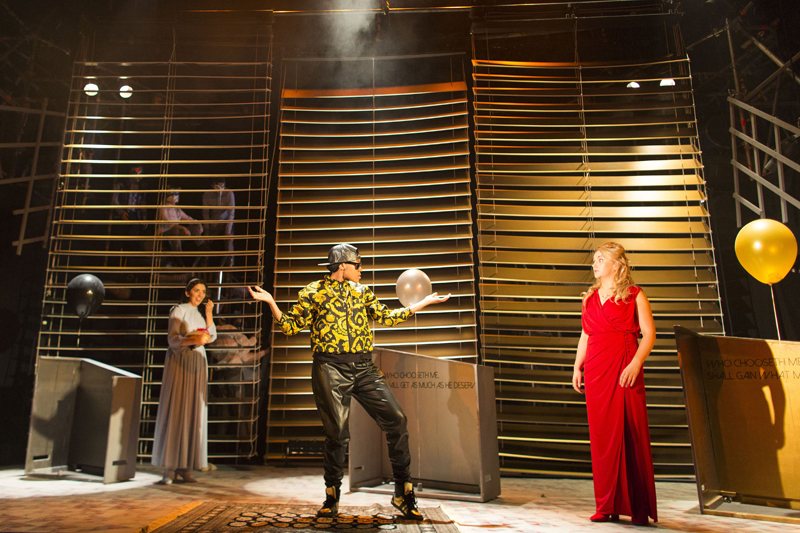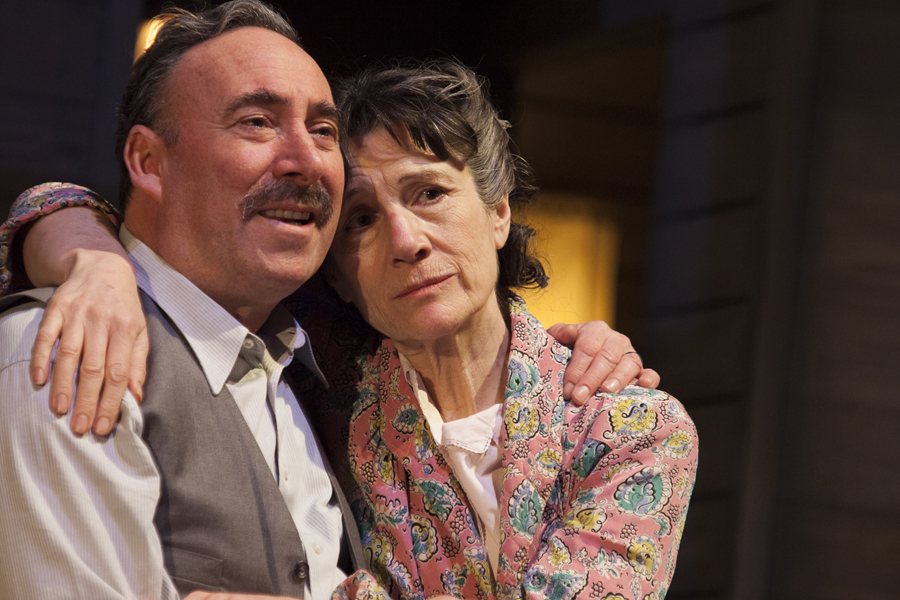 The 500th anniversary of the Venice Ghetto might take place in 2016, but I feel as if I’ve already spent some time with its embattled Jewish community, at least as seen through Shakespeare’s eyes, as I watch The Merchant of Venice for the fourth time this year.
The 500th anniversary of the Venice Ghetto might take place in 2016, but I feel as if I’ve already spent some time with its embattled Jewish community, at least as seen through Shakespeare’s eyes, as I watch The Merchant of Venice for the fourth time this year.
I guess this might be in contrast to the excited, noisily appreciative, mostly young audience at the National Youth Theatre's sparky and sparklingly funny production. Even if they are studying the play at school, this might be the first time they've seen it, so it’s good to be able to report how much they enjoyed a comic treat. The play is after all dubbed a comedy, even though it also presents huge problems and not just for the Jews in the audience.
The young cast is not afraid to hit those problems head on. The NYT originally performed this version by Tom Stoppard in China in 2008 with a cast made up of both young British and Chinese actors. This was the year of the Beijng Olympics, so they experienced artistic censorship “heightened by human rights controversy”, writes director Anna Niland in a programme note. Despite this, she continues, “the play’s themes of persecution, racism and inclusion rang true to local audiences and our young international cast.
"With Italy experiencing an immigration crisis that brings these themes to the fore, I have decided to set the play in modern Venice. However, I also think it’s crucial to hang onto a semblance of the historic Venice Shakespeare was writing about.” She goes on to talk about exploring the play through the eyes of Shylock the ‘alien’ and posits that the production “will ask how much has really changed for those considered alien today.”
The production sets out its stall before the play begins, with establishing shots – silent face-offs between the main protagonists, much of it to the gorgeous accompaniment of composer and musical director Tristan Parkes’ setting of 'In Belmont lives a lady…' perfect for Grace Surey's smoky voice. She is surely a future jazz star. The Christians may exchange meaningful glances, perhaps to establish the possibly homoerotic relationship between Antonio and Bassanio, but all of them glare at Shylock. Andrew Hanratty’s Antonio has a gravitas beyond his years and Jason Imlach’s Bassanio sports a useful beard which gives him maturity too. Add to this Luke Pierre’s tall, rather elegant Shylock and it’s easy to take all three very seriously indeed.
And just because Pierre’s Shylock is so dignified, the contempt in which he is held by Antonio and Bassanio, and later his humiliation and ruin by Portia in court, have the power to shock. True, Shylock and Antonio gingerly shake hands, which is more contact than I’ve seen in other productions this year, but then the eponymous merchant does indeed ‘spit upon’ Shylock’s ‘Jewish gabardine’. I’ll assume the couple of titters evoked by those Jew-baiters and haters Salerio and Salanio (a vicious double act from Oliver West and Conor Meaves) thrusting the pig-head masks they are wearing at Shylock, were down to discomfort.
The gabardine in question is made rather a colourful affair by the addition of coloured ribbons at the waist, evoking tzitzes (the prayer fringes of the Orthodox Jew) with the colours perhaps also suggesting the Spanish origins of this Sephardi Jew.

Cecilia Carey's striking costume and design are a vital part of Niland's bold concept. Her Carnival-time Venice is exuberantly, edgily stylish but in its own almost eccentric way. True the Carnival masks are traditional, but Alice Feetham's poised, intelligent Portia is a lady in red with a style and sexy panache all her own. It's in eye-catching contrast to Jessica's black and pink pleats beneath a clever cape which becomes a hood when she pulls it over her head, as a modest Jewish maiden should, to go outdoors.
But the apogee of her costume design is surely the extraordinary confection sported by Lauren Lyle's wildly funny Prince of Arrogan (their spelling - possibly Stoppard's - not mine!). Lyle brilliantly exploits its slinky contours and purple sash to create her comically androgynous suitor and relishes sashaying on impossibly high platforms, as she quite literally feels up each of the 'caskets' as if it were Portia herself! Before I leave the clever cross casting in the comedy roles that ensures jobs for the girls, let me make honourable mention of Paris Campbell's equally ardent Prince of Morocco; and Megan Parkinson's Lancelot Gobbo, the cheekily insouciant servant leaving Shylock's service for Bassanio's, together with versatile Grace Surey as Old Gobbo, his parent, here transformed into Old 'Mother' Gobbo - rather a fine below stairs double act.
This all matches Carey's equally quirky stage design, simple and versatile. The action takes place against a backdrop of huge Venetian (naturally) blinds and those three 'caskets' are actually three wooden structures that work separately or together to create steps, beds and the witness boxes in the courtroom scene.
Their quirkiest use though, is as those caskets, each flying a balloon of the relevant colour, gold, silver and of course lead! But happily there’s no way the so-called casket scene goes down like the proverbial lead balloon! The wickedly playful ‘Team Belmont’ of Feetham’s Portia and Melissa Taylor’s cheerful, wise-cracking Nerissa have a great time sending up the suitors Portia must entertain; and Nerissa’s gleeful rendering of a relevant musical number for each casket – e.g. ‘Hi Ho Silver Lining’ for the silver casket - goes down a treat with the audience, who joined in and sang along. Mistress and waiting gentlewoman work up an authentic tension as Bassanio rejects each wrong casket in turn and Portia and Bassanio achieve a touching tenderness as they fall into each other’s arms in relief.
Meanwhile, the tension in the home life of Shylock and Jessica is a much darker affair. Though again the production achieves a touching moment – for me perhaps the most telling. At the climax of the very few lines they share, it’s actually a mute moment. In one of the most moving gestures of the production, Francene Turner’s Jessica, about to leave her father forever, cannot go without giving him a last desperate, lingering hug – a hug that clearly takes him by surprise and moves him too. It's all the more poignant because he does not know its significance. When he learns it though, his rage is all the more understandable, so he earns sympathy when Oscar Porter-Brentford’s supportive Tubal reports that the errant Jessica has given away her late mother’s engagement ring in exchange for a monkey.
Given that a female Doge (stately Ellise Chappell) presides over Venice's court, it might be considered an anomaly that Portia has to disguise herself as a man to appear as a lawyer, but, if anything, in this modern setting it genuinely raises eyebrows that she has to do so, perhaps just because it reminds the audience of the realities of life for women in some countries today. Of course though, for the comedy to work, Bassanio and Gratiano must not recognise their brand new wives, so disguise is a given. Cole Edwards’ Gratiano achieves the brash comedy in his role and displays the casual racism written into his character and Gavi Singh Chera is a Lorenzo as interested in his bride as in her fortune.
Although I’m not entirely convinced that the production draws the parallels with today’s immigration crisis, I am sure that this fresh reading of the play ensures that those who have seen it before take a fresh look at it and those who are new to it will have a clear idea of the comedy and the problems – and what all the fuss is about.
By Judi Herman
The Merchant of Venice runs until Wednesday 2 December. 7.30pm & 2.30pm. £12-£19.50. National Theatre, South Bank, SE1 9PX; 020 7452 3000. www.nationaltheatre.org.uk
 I saw the original production of Harold Pinter’s dark, multi-award-winning comedy as a precocious, theatre-mad teenager. I wouldn't have been allowed near it if it had been a film, it would have been x-rated in those days for sure! The homecoming of the title is the return to the flinty bosom of his East End family of Teddy, a college lecturer Stateside with a murky past in this all-male household ruled over by retired butcher Max. Teddy brings home the, er, "bacon" in the alluring shape of Ruth, his wife of five years. The power play between the brothers, their father and above all between Ruth and her in-laws is the meat of the play. I particularly remember Ian Holm, sinister and dangerous as Lenny the pimp; and Vivien Merchant, Pinter’s first wife, who created the role of Ruth, and the way she crossed her legs causing shock waves to ripple through the theatre – and I don't mean because of the static in her nylons…
I saw the original production of Harold Pinter’s dark, multi-award-winning comedy as a precocious, theatre-mad teenager. I wouldn't have been allowed near it if it had been a film, it would have been x-rated in those days for sure! The homecoming of the title is the return to the flinty bosom of his East End family of Teddy, a college lecturer Stateside with a murky past in this all-male household ruled over by retired butcher Max. Teddy brings home the, er, "bacon" in the alluring shape of Ruth, his wife of five years. The power play between the brothers, their father and above all between Ruth and her in-laws is the meat of the play. I particularly remember Ian Holm, sinister and dangerous as Lenny the pimp; and Vivien Merchant, Pinter’s first wife, who created the role of Ruth, and the way she crossed her legs causing shock waves to ripple through the theatre – and I don't mean because of the static in her nylons…



















